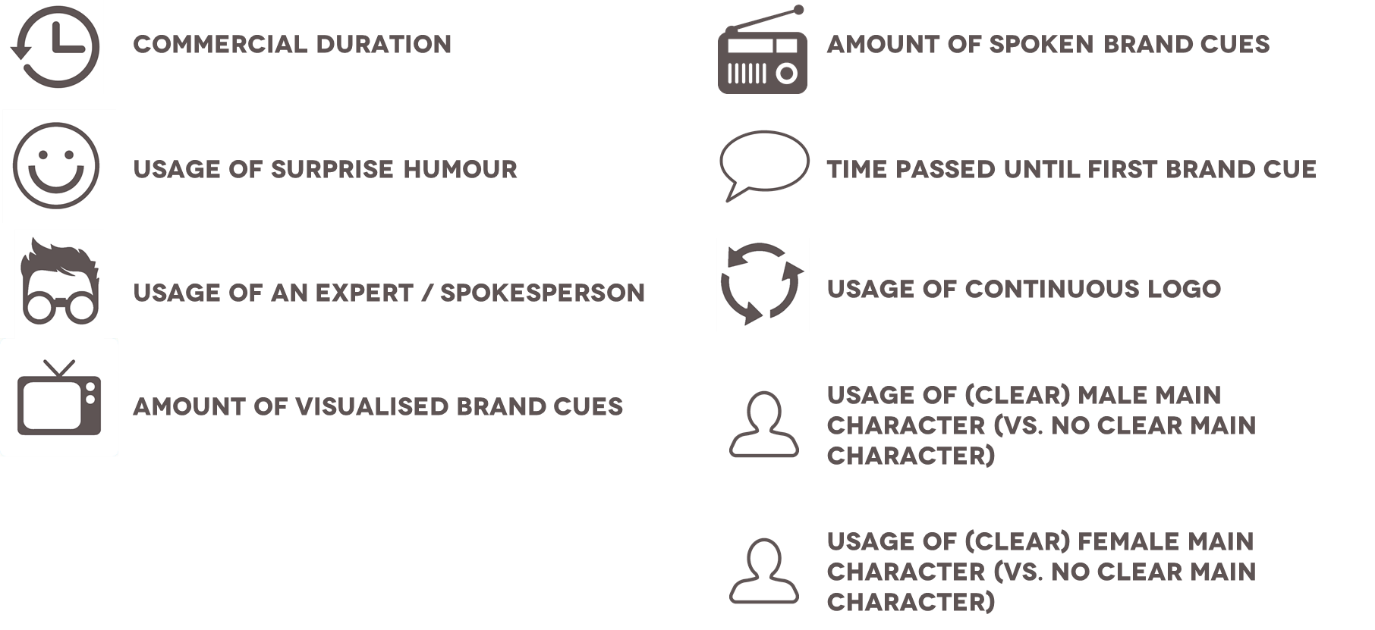Which content characteristics of TV commercials influence brand impact?
Published on 14 03 2019As a marketing research company, we don’t just conduct studies for clients. We use our research to learn from our own insights. Over the years, we have tested hundreds of TV commercials. Together, they provide a tremendous amount of information. That’s why we decided to carry out a meta-analysis with our TV copy testing database. A meta-analysis is a research where the results of previous studies are collected and analysed, in order to achieve a general conclusion.
Which elements contribute to the effectiveness of a TV Commercial?
Is it humour? Or the duration of the commercial? Or does it perhaps have to do with the gender of the main character? DVJ conducted a meta-analysis to find out which elements in TV commercials influence brand impact. If we know which characteristics influence brand impact, clients could use this to their advantage to increase the effectiveness of their commercial.
The elements in this study are the ones that stood out, we don’t exclude the rest, these are just the ones we tested.
Among this analysis we also studied which Top 7 KPI’s drive brand impact, and analysed what makes a TVC effective.
The meta-analysis
To find out which content characteristics contribute to the effectiveness of a TVC, we tested different characteristics based on academic literature that potentially have an influence on the effectiveness of TVC’s. There are many characteristics that could influence TVC’s, these are just the ones we used in this meta-analysis based on literature. We tested the influence the characteristics have on the two brand impact scores: unaided brand recall and message clarity. Prior research showed that these two scores are the most important predictors for the in-market performance of a commercial. We used commercials from different European countries for this analysis. We looked at commercials from The Netherlands, The UK and Ireland, Germany, Poland and Switzerland.
The content characteristics
Each commercial in the different databases we tested was scored on these dimensions. The characteristics are shown in Figure 1.

Figure 1
We looked at 9 different characteristics. The duration of the commercial, the use of surprise humour in a commercial, the use of an expert or spokesperson, the amount of visualised brand cues (such as products or logo’s), the amount of spoken brand cues (such as the name of the brand), the time passed until the first brand cue (for example a logo), the use of a continuous logo in a commercial, and finally, the use of a clear male or female character.
By looking at these characteristics in over 100 commercials, we could establish the characteristics that have a significant positive effect, no significant effect, and a significant negative effect. The characteristics were the duration of the video, the element of surprise in combination with humour, the presence of an expert, whether the brand could be seen in the video and/or whether the brand was in the audio of the video, the time passed until the first brand cue, whether the commercial had a continuous logo visible, and whether there was a main character present, either male or female.
Positive effect
Message clarity
Almost all the characteristics have an influence on the clearness of the message as shown in Figure 2, except for the presence of an expert. So, for example, the longer the duration of the commercial, the clearer the message will be.

Figure 2
Unaided brand recall
The duration of a commercial, the presence of surprise and humour and a male main character positively influence the unaided brand recall, as shown in Figure 3. Expert, brand audio, brand video, continuous logo and female main character don’t have a significant influence on remembering the brand spontaneously. So, for example, when you want people to remember your brand, the use of surprise humour in your commercial contributes to that.

Figure 3
Negative effect
Message clarity and unaided brand recall
The time passed until the first brand cue is important, as shown in Figure 4. The sooner the brand is mentioned, the better the clarity of the message and the better the unaided brand recall. However, using a continuous logo in your TVC, doesn’t do the trick. This is because it worsens the message clarity. Probably because it distracts from the content of the TVC.

Figure 4
Our TV copy-test
DVJ Insights’ TV copy-test takes into account the way in which people look at advertising as well as the role of emotions in advertising. Pre-testing your TV commercial is crucial when optimising and increasing your ad. Because media investments typically constitute the largest costs associated with a campaign, pre-testing prevents you from wasting your advertising budget. Our copy-test combines registration, and implicit and explicit research techniques, to expose the full potential of the TVC. By comparing this with a robust benchmark, every advertiser immediately knows whether and how improvements are possible.
Contact us for more information about our copy-test.